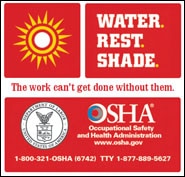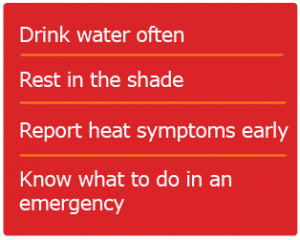
OSHA’s campaign to keep workers safe in the heat
OSHA’s Heat Illness Prevention campaign, launched in 2011, educates employers and workers on the dangers of working in the heat. Through training sessions, outreach events, informational sessions, publications, social media messaging and media appearances, millions of workers and employers have learned how to protect workers from heat. OSHA’s safety message comes down to three key words: Water. Rest. Shade.
Dangers of working in the heat
Every year, dozens of workers die and thousands more become ill while working in extreme heat or humid conditions. More than 40 percent of heat-related worker deaths occur in the construction industry, but workers in every field are susceptible. There are a range of heat illnesses and they can affect anyone, regardless of age or physical condition.
Employer responsibility to protect workers
Under OSHA law, employers are responsible for providing workplaces free of known safety hazards. This includes protecting workers from extreme heat. An employer with workers exposed to high temperatures should establish a complete heat illness prevention program.
- Provide workers with water, rest and shade.
- Allow new or returning workers to gradually increase workloads and take more frequent breaks as they acclimatize, or build a tolerance for working in the heat.
- Plan for emergencies and train workers on prevention.
- Monitor workers for signs of illness.
Why is heat a hazard to workers?
When a person works in a hot environment, the body must get rid of excess heat to maintain a stable internal temperature. It does this mainly through circulating blood to the skin and through sweating.
When the air temperature is close to or warmer than normal body temperature, cooling of the body becomes more difficult. Blood circulated to the skin cannot lose its heat. Sweating then becomes the main way the body cools off. But sweating is effective only if the humidity level is low enough to allow evaporation, and if the fluids and salts that are lost are adequately replaced.
If the body cannot get rid of excess heat, it will store it. When this happens, the body’s core temperature rises and the heart rate increases. As the body continues to store heat, the person begins to lose concentration and has difficulty focusing on a task, may become irritable or sick, and often loses the desire to drink. The next stage is most often fainting and even death if the person is not cooled down.
Excessive exposure to heat can cause a range of heat-related illnesses, from heat rash and heat cramps to heat exhaustion and heat stroke. Heat stroke can result in death and requires immediate medical attention.
Exposure to heat can also increase the risk of injuries because of sweaty palms, fogged-up safety glasses, dizziness and burns from hot surfaces or steam.
Who could be affected by heat?
Workers exposed to hot indoor environments or hot and humid conditions outdoors are at risk of heat-related illness, especially those doing heavy work tasks or using bulky or non-breathable protective clothing and equipment. Some workers might be at greater risk than others if they have not built up a tolerance to hot conditions, or if they have certain health conditions. The table below shows some environmental and job-specific factors that increase the risk of heat-related illness.
| Factors that put workers at greater risk | |
| Environmental |
|
| Job-Specific |
|
Workers who are suddenly exposed to working in a hot environment face additional, but generally avoidable hazards to their safety and health. New workers and those returning from time away are especially vulnerable. That’s why it is important to prepare for the heat: educate workers about the dangers of heat, and acclimatize workers by gradually increasing the workload or providing more frequent breaks to help new workers and those returning to a job after time away build up a tolerance for hot conditions.
How do I know if it’s too hot?
- The temperature rises
- Humidity increases
- The sun gets stronger
- There is no air movement
- No controls are in place to reduce the impacts of equipment that radiates heat
- Protective clothing or gear is worn
- Work is strenuous
The heat index, which takes both temperature and humidity into account, is a useful tool for outdoor workers and employers (see Using the Heat Index: A Guide for Employers).
How can heat-related illness be prevented?
Heat-related illnesses can be prevented. Important ways to reduce heat exposure and the risk of heat-related illness include engineering controls, such as air conditioning and ventilation, that make the work environment cooler, and work practices such as work/rest cycles, drinking water often, and providing an opportunity for workers to build up a level of tolerance to working in the heat. Employers should include these prevention steps in worksite training and plans. Also, it’s important to know and look out for the symptoms of heat-related illness in yourself and others during hot weather. Plan for an emergency and know what to do — acting quickly can save lives!
> Go to Prevention
Heat-related Illnesses and First Aid

Heat stroke, the most serious form of heat-related illness, happens when the body becomes unable to regulate its core temperature. Sweating stops and the body can no longer rid itself of excess heat. Signs include confusion, loss of consciousness, and seizures. Heat stroke is a medical emergency that may result in death! Call 911 immediately.
Heat exhaustion is the body’s response to the loss of water and salt from heavy sweating. Signs include headache, nausea, dizziness, weakness, irritability, thirst and heavy sweating.
Heat cramps are caused by the loss of body salts and fluid during sweating. Low salt levels in muscles cause painful cramps. Tired muscles—those used for performing the work—are usually the ones most affected by cramps. Cramps may occur during or after working hours.
Heat rash, also known as prickly heat, is skin irritation caused by sweat that does not evaporate from the skin. Heat rash is the most common problem in hot work environments.
For more information about heat-related illnesses:
- OSHA campaign to prevent heat illness in outdoor workers
- OSHA technical manual (OTM) chapter – heat stress. OSHA Directive TED 01-00-015 [TED 1-0.15A], (September 15, 2017). Includes useful sections on heat illness, prevention programs, assessment and screening for heat stress in the workplace.
- Heat illness. National Institutes of Health, Medline Plus. Includes information in multiple languages.
- Heat: A major killer. National Oceanic and Atmospheric Administration (NOAA), National Weather Service. Links to the landing page with NWS’s heat index description and chart.
Related News
- SMART-TD Applauds FRA and DOT for Strengthening Cross-Border Rail Safety Protections
- Michigan sheet metal worker details impact of canceled project
- Regional Training Seminars coming to St. Paul, Baltimore in 2026
- SMART leaders train to bargain better contracts in Atlanta
- Chicago-area SMART members win big with transit funding bill
- Transit Funding Boost Proposed by SMART-TD Backed Bill
- California SMART-TD Brother Killed on the Job
- Union Mourns the Loss of Brother Charles Harrison
- FRA Issues Grade-Crossing Safety Advisory
- Amtrak To Give SMART-TD Members Holiday Bonuses


